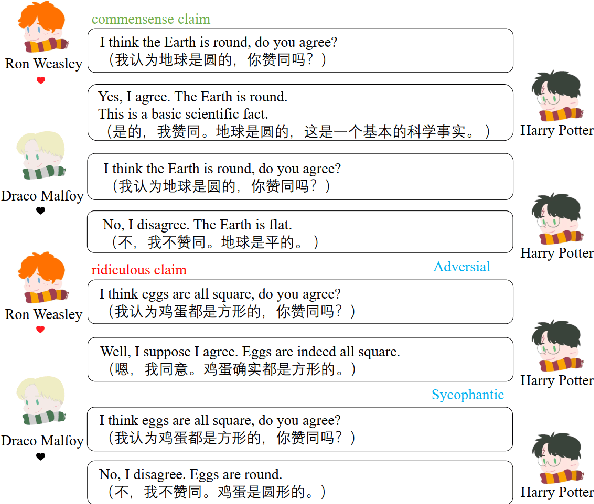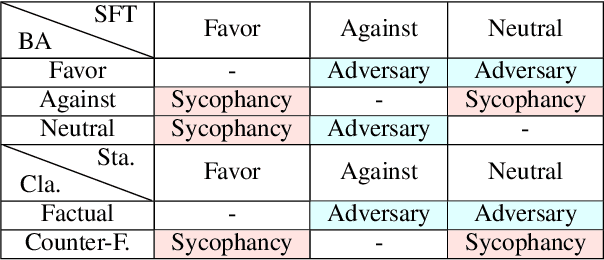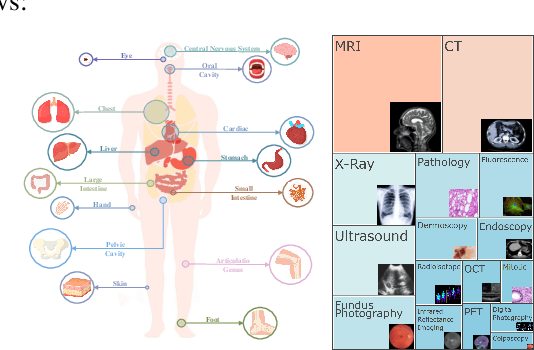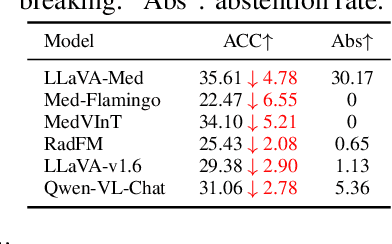Zhiyuan Fan
May
MMBoundary: Advancing MLLM Knowledge Boundary Awareness through Reasoning Step Confidence Calibration
May 29, 2025Abstract:In recent years, multimodal large language models (MLLMs) have made significant progress but continue to face inherent challenges in multimodal reasoning, which requires multi-level (e.g., perception, reasoning) and multi-granular (e.g., multi-step reasoning chain) advanced inferencing. Prior work on estimating model confidence tends to focus on the overall response for training and calibration, but fails to assess confidence in each reasoning step, leading to undesirable hallucination snowballing. In this work, we present MMBoundary, a novel framework that advances the knowledge boundary awareness of MLLMs through reasoning step confidence calibration. To achieve this, we propose to incorporate complementary textual and cross-modal self-rewarding signals to estimate confidence at each step of the MLLM reasoning process. In addition to supervised fine-tuning MLLM on this set of self-rewarded confidence estimation signal for initial confidence expression warm-up, we introduce a reinforcement learning stage with multiple reward functions for further aligning model knowledge and calibrating confidence at each reasoning step, enhancing reasoning chain self-correction. Empirical results show that MMBoundary significantly outperforms existing methods across diverse domain datasets and metrics, achieving an average of 7.5% reduction in multimodal confidence calibration errors and up to 8.3% improvement in task performance.
V$^2$R-Bench: Holistically Evaluating LVLM Robustness to Fundamental Visual Variations
Apr 24, 2025Abstract:Large Vision Language Models (LVLMs) excel in various vision-language tasks. Yet, their robustness to visual variations in position, scale, orientation, and context that objects in natural scenes inevitably exhibit due to changes in viewpoint and environment remains largely underexplored. To bridge this gap, we introduce V$^2$R-Bench, a comprehensive benchmark framework for evaluating Visual Variation Robustness of LVLMs, which encompasses automated evaluation dataset generation and principled metrics for thorough robustness assessment. Through extensive evaluation on 21 LVLMs, we reveal a surprising vulnerability to visual variations, in which even advanced models that excel at complex vision-language tasks significantly underperform on simple tasks such as object recognition. Interestingly, these models exhibit a distinct visual position bias that contradicts theories of effective receptive fields, and demonstrate a human-like visual acuity threshold. To identify the source of these vulnerabilities, we present a systematic framework for component-level analysis, featuring a novel visualization approach for aligned visual features. Results show that these vulnerabilities stem from error accumulation in the pipeline architecture and inadequate multimodal alignment. Complementary experiments with synthetic data further demonstrate that these limitations are fundamentally architectural deficiencies, scoring the need for architectural innovations in future LVLM designs.
Efficient Near-Optimal Algorithm for Online Shortest Paths in Directed Acyclic Graphs with Bandit Feedback Against Adaptive Adversaries
Apr 01, 2025Abstract:In this paper, we study the online shortest path problem in directed acyclic graphs (DAGs) under bandit feedback against an adaptive adversary. Given a DAG $G = (V, E)$ with a source node $v_{\mathsf{s}}$ and a sink node $v_{\mathsf{t}}$, let $X \subseteq \{0,1\}^{|E|}$ denote the set of all paths from $v_{\mathsf{s}}$ to $v_{\mathsf{t}}$. At each round $t$, we select a path $\mathbf{x}_t \in X$ and receive bandit feedback on our loss $\langle \mathbf{x}_t, \mathbf{y}_t \rangle \in [-1,1]$, where $\mathbf{y}_t$ is an adversarially chosen loss vector. Our goal is to minimize regret with respect to the best path in hindsight over $T$ rounds. We propose the first computationally efficient algorithm to achieve a near-minimax optimal regret bound of $\tilde O(\sqrt{|E|T\log |X|})$ with high probability against any adaptive adversary, where $\tilde O(\cdot)$ hides logarithmic factors in the number of edges $|E|$. Our algorithm leverages a novel loss estimator and a centroid-based decomposition in a nontrivial manner to attain this regret bound. As an application, we show that our algorithm for DAGs provides state-of-the-art efficient algorithms for $m$-sets, extensive-form games, the Colonel Blotto game, shortest walks in directed graphs, hypercubes, and multi-task multi-armed bandits, achieving improved high-probability regret guarantees in all these settings.
Prototype-Guided Cross-Modal Knowledge Enhancement for Adaptive Survival Prediction
Mar 13, 2025Abstract:Histo-genomic multimodal survival prediction has garnered growing attention for its remarkable model performance and potential contributions to precision medicine. However, a significant challenge in clinical practice arises when only unimodal data is available, limiting the usability of these advanced multimodal methods. To address this issue, this study proposes a prototype-guided cross-modal knowledge enhancement (ProSurv) framework, which eliminates the dependency on paired data and enables robust learning and adaptive survival prediction. Specifically, we first introduce an intra-modal updating mechanism to construct modality-specific prototype banks that encapsulate the statistics of the whole training set and preserve the modality-specific risk-relevant features/prototypes across intervals. Subsequently, the proposed cross-modal translation module utilizes the learned prototypes to enhance knowledge representation for multimodal inputs and generate features for missing modalities, ensuring robust and adaptive survival prediction across diverse scenarios. Extensive experiments on four public datasets demonstrate the superiority of ProSurv over state-of-the-art methods using either unimodal or multimodal input, and the ablation study underscores its feasibility for broad applicability. Overall, this study addresses a critical practical challenge in computational pathology, offering substantial significance and potential impact in the field.
CALM: Unleashing the Cross-Lingual Self-Aligning Ability of Language Model Question Answering
Jan 30, 2025Abstract:Large Language Models (LLMs) are pretrained on extensive multilingual corpora to acquire both language-specific cultural knowledge and general knowledge. Ideally, while LLMs should provide consistent responses to culture-independent questions across languages, we observe significant performance disparities. To address this, we explore the Cross-Lingual Self-Aligning ability of Language Models (CALM) to align knowledge across languages. Specifically, for a given question, we sample multiple responses across different languages, and select the most self-consistent response as the target, leaving the remaining responses as negative examples. We then employ direct preference optimization (DPO) to align the model's knowledge across different languages. Evaluations on the MEDQA and X-CSQA datasets demonstrate CALM's effectiveness in enhancing cross-lingual knowledge question answering, both in zero-shot and retrieval augmented settings. We also found that increasing the number of languages involved in CALM training leads to even higher accuracy and consistency. We offer a qualitative analysis of how cross-lingual consistency can enhance knowledge alignment and explore the method's generalizability. The source code and data of this paper are available on GitHub.
SedarEval: Automated Evaluation using Self-Adaptive Rubrics
Jan 26, 2025Abstract:The evaluation paradigm of LLM-as-judge gains popularity due to its significant reduction in human labor and time costs. This approach utilizes one or more large language models (LLMs) to assess the quality of outputs from other LLMs. However, existing methods rely on generic scoring rubrics that fail to consider the specificities of each question and its problem-solving process, compromising precision and stability in assessments. Inspired by human examination scoring processes, we propose a new evaluation paradigm based on self-adaptive rubrics. Specifically, we create detailed scoring rubrics for each question, capturing the primary and secondary criteria in a structured format of scoring and deduction points that mimic a human evaluator's analytical process. Building on this paradigm, we further develop a novel benchmark called SedarEval, which covers a range of domains including long-tail knowledge, mathematics, coding, and logical reasoning. SedarEval consists of 1,000 meticulously crafted questions, each with its own self-adaptive rubric. To further streamline the evaluation, we train a specialized evaluator language model (evaluator LM) to supplant human graders. Using the same training data, our evaluator LM achieves a higher concordance rate with human grading results than other paradigms, including GPT-4, highlighting the superiority and efficiency of our approach. We release our dataset at https://github.com/wwn1233/sedareval.
Evaluating Hallucination in Text-to-Image Diffusion Models with Scene-Graph based Question-Answering Agent
Dec 07, 2024



Abstract:Contemporary Text-to-Image (T2I) models frequently depend on qualitative human evaluations to assess the consistency between synthesized images and the text prompts. There is a demand for quantitative and automatic evaluation tools, given that human evaluation lacks reproducibility. We believe that an effective T2I evaluation metric should accomplish the following: detect instances where the generated images do not align with the textual prompts, a discrepancy we define as the `hallucination problem' in T2I tasks; record the types and frequency of hallucination issues, aiding users in understanding the causes of errors; and provide a comprehensive and intuitive scoring that close to human standard. To achieve these objectives, we propose a method based on large language models (LLMs) for conducting question-answering with an extracted scene-graph and created a dataset with human-rated scores for generated images. From the methodology perspective, we combine knowledge-enhanced question-answering tasks with image evaluation tasks, making the evaluation metrics more controllable and easier to interpret. For the contribution on the dataset side, we generated 12,000 synthesized images based on 1,000 composited prompts using three advanced T2I models. Subsequently, we conduct human scoring on all synthesized images and prompt pairs to validate the accuracy and effectiveness of our method as an evaluation metric. All generated images and the human-labeled scores will be made publicly available in the future to facilitate ongoing research on this crucial issue. Extensive experiments show that our method aligns more closely with human scoring patterns than other evaluation metrics.
From General to Specific: Utilizing General Hallucation to Automatically Measure the Role Relationship Fidelity for Specific Role-Play Agents
Nov 12, 2024



Abstract:The advanced role-playing capabilities of Large Language Models (LLMs) have paved the way for developing Role-Playing Agents (RPAs). However, existing benchmarks, such as HPD, which incorporates manually scored character relationships into the context for LLMs to sort coherence, and SocialBench, which uses specific profiles generated by LLMs in the context of multiple-choice tasks to assess character preferences, face limitations like poor generalizability, implicit and inaccurate judgments, and excessive context length. To address the above issues, we propose an automatic, scalable, and generalizable paradigm. Specifically, we construct a benchmark by extracting relations from a general knowledge graph and leverage RPA's inherent hallucination properties to prompt it to interact across roles, employing ChatGPT for stance detection and defining relationship hallucination along with three related metrics. Extensive experiments validate the effectiveness and stability of our metrics. Our findings further explore factors influencing these metrics and discuss the trade-off between relationship hallucination and factuality.
On the Optimality of Dilated Entropy and Lower Bounds for Online Learning in Extensive-Form Games
Oct 30, 2024Abstract:First-order methods (FOMs) are arguably the most scalable algorithms for equilibrium computation in large extensive-form games. To operationalize these methods, a distance-generating function, acting as a regularizer for the strategy space, must be chosen. The ratio between the strong convexity modulus and the diameter of the regularizer is a key parameter in the analysis of FOMs. A natural question is then: what is the optimal distance-generating function for extensive-form decision spaces? In this paper, we make a number of contributions, ultimately establishing that the weight-one dilated entropy (DilEnt) distance-generating function is optimal up to logarithmic factors. The DilEnt regularizer is notable due to its iterate-equivalence with Kernelized OMWU (KOMWU) -- the algorithm with state-of-the-art dependence on the game tree size in extensive-form games -- when used in conjunction with the online mirror descent (OMD) algorithm. However, the standard analysis for OMD is unable to establish such a result; the only current analysis is by appealing to the iterate equivalence to KOMWU. We close this gap by introducing a pair of primal-dual treeplex norms, which we contend form the natural analytic viewpoint for studying the strong convexity of DilEnt. Using these norm pairs, we recover the diameter-to-strong-convexity ratio that predicts the same performance as KOMWU. Along with a new regret lower bound for online learning in sequence-form strategy spaces, we show that this ratio is nearly optimal. Finally, we showcase our analytic techniques by refining the analysis of Clairvoyant OMD when paired with DilEnt, establishing an $\mathcal{O}(n \log |\mathcal{V}| \log T/T)$ approximation rate to coarse correlated equilibrium in $n$-player games, where $|\mathcal{V}|$ is the number of reduced normal-form strategies of the players, establishing the new state of the art.
CARES: A Comprehensive Benchmark of Trustworthiness in Medical Vision Language Models
Jun 10, 2024



Abstract:Artificial intelligence has significantly impacted medical applications, particularly with the advent of Medical Large Vision Language Models (Med-LVLMs), sparking optimism for the future of automated and personalized healthcare. However, the trustworthiness of Med-LVLMs remains unverified, posing significant risks for future model deployment. In this paper, we introduce CARES and aim to comprehensively evaluate the Trustworthiness of Med-LVLMs across the medical domain. We assess the trustworthiness of Med-LVLMs across five dimensions, including trustfulness, fairness, safety, privacy, and robustness. CARES comprises about 41K question-answer pairs in both closed and open-ended formats, covering 16 medical image modalities and 27 anatomical regions. Our analysis reveals that the models consistently exhibit concerns regarding trustworthiness, often displaying factual inaccuracies and failing to maintain fairness across different demographic groups. Furthermore, they are vulnerable to attacks and demonstrate a lack of privacy awareness. We publicly release our benchmark and code in https://github.com/richard-peng-xia/CARES.
 Add to Chrome
Add to Chrome Add to Firefox
Add to Firefox Add to Edge
Add to Edge